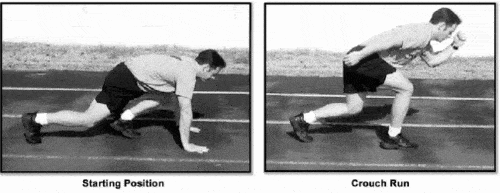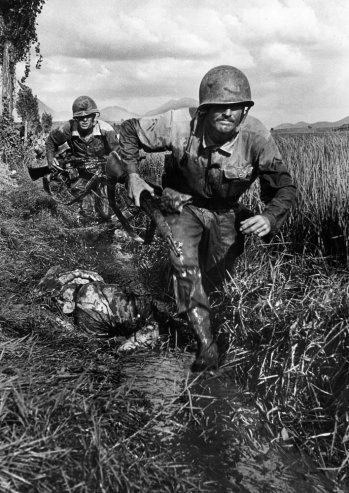The Crouch Run is a specific exercise performed in military training, designed to enhance agility, speed, and coordination while maintaining a low body position. It involves moving rapidly in a semi-crouched stance.
The crouch run is the third exercise in Military Movement Drill 2 (MMD 2).
The other two Army MMD2 Drills are as follows:
This exercise mimics the movements a soldier might need to use in combat situations when there’s a need to move swiftly while staying low to the ground to avoid detection or incoming fire.
Military Movement Drill 2: Crouch Run Exercise 3

- Purpose: This exercise develops the ability to run quickly in a crouched position.
- Starting Position: Assume the starting position for exercise three of CD 1: mountain climber.
Movement:
- Power out of the starting position, performing one repetition of a mountain climber.
- Upon finishing count 4, run forward in the crouch position to the 25-yard mark.
- Turn clockwise while planting the left foot and bending and squatting to touch the ground with the left hand, as in performing the shuttle sprint in MMD1.
- Crouch run quickly back to the starting line and plant the right foot, turn counter-clockwise and touch the ground with the right hand.
- Accelerate out of the crouch run to an upright position, and sprint back to the 25-yard mark, gradually accelerating to near maximum speed.
Check Points:
| Step | Description |
|---|---|
| Start | Move from the crouch run starting position by executing one repetition of mountain climber and firing out of count four with the right leg and swinging the left arm forward to the crouch run. |
| During the Run | On the crouch run, stay low with minimal arm swing. Soldiers should slow their movement before planting their feet and changing direction. |
| Turning | Soldiers should squat while bending the trunk when reaching to touch the ground as they change direction. |
| Hand Touch | Soldiers touch the ground with their left hand on the first turn, then with their right hand on the second turn. |
| Acceleration | Accelerate to near maximum speed during the last 25-yard interval. |
Precaution: Soldiers should use caution when performing this exercise on wet terrain.
Benefits of Crouch Run Exercise
The crouch run offers a wide range of physical and mental benefits.
Here are some of the top advantages of incorporating this exercise into your fitness routine:
- Improves lower body strength: Crouch running targets the muscles in your legs, glutes, and hips, helping to build strength and endurance.
- Boosts cardiovascular endurance: As an aerobic exercise, crouch running helps to increase your heart rate and improve overall cardiovascular health.
- Enhances speed and agility: By training in a low, crouched position, you’ll develop the ability to move quickly and change direction easily – a valuable skill for athletes in various sports.
- Promotes weight loss: Like regular running, crouch running is an effective way to burn calories and shed excess body fat.
- Improves sports performance: Crouch running can help athletes in sports like football, basketball, and track and field improve their acceleration, explosive power, and quick directional changes.

Crouch Drills and Variations
To keep your crouch run workouts fresh and challenging, try incorporating some of these drills and variations:
- Crouch run sprints: Perform short bursts of crouch running at maximum speed, followed by a brief recovery period.
- Crouch run shuttle: Set up cones or markers at varying distances and sprint between them while maintaining a crouched position.
- Crouch run with resistance: Add resistance bands or a weighted vest to increase the intensity of your crouch run workout.
- Crouch run on an incline: Perform crouch runs uphill to challenge your leg muscles and cardiovascular endurance further.
- Crouch run relay: Partner up and take turns performing crouch runs, racing against each other or working together to complete a set distance.
Crouch Run vs. Regular Running
While both crouch running and regular running offer numerous benefits, there are some critical differences between the two exercises:
- Technique: Crouch running requires maintaining a low body position, which places more emphasis on lower body muscles and challenges your balance and coordination.
- Intensity: Due to the added challenge of maintaining a crouched position, crouch running is generally more intense and demanding than regular running.
- Muscle activation: Crouch running engages your glutes, hamstrings, and quads more than regular running, making it an excellent exercise for targeting lower body strength.
- Application to sports: Crouch running is particularly beneficial for athletes who need to develop explosive power, quick directional changes, and acceleration, like football players, sprinters, and basketball players.
Creating a Run Workout Routine
To incorporate crouch running into your fitness routine, consider the following tips:
- Start with a warm-up: Begin each workout with a dynamic introduction to prepare your muscles and joints for the crouch run exercise.
- Gradually increase intensity: As you become more comfortable with the crouch run technique, increase the power by adding resistance, inclines, or longer distances.
- Mix in other exercises: Combine crouch runs with other practices, such as lunges, squats, and plyometrics, to create a well-rounded workout.
- Track your progress: Monitor your improvement over time by recording your distances, times, or the number of repetitions completed during each workout.
- Rest and recover: Give your muscles time to repair and grow by taking rest days and incorporating stretching and foam rolling into your routine.
Conclusion
Crouch running is an exciting and challenging exercise that can significantly impact your fitness.
By mastering the proper technique, exploring various drills and variations, and incorporating it into your regular workout routine, you can unlock numerous benefits, including improved speed, agility, and overall performance.
- Empowering Transactions: Navigating Firearms Sales with Proper Documentation - April 8, 2024
- Army PRT – Preparation and Recovery 2024 - March 18, 2024
- Active and Reserve Components 2024 - March 6, 2024
